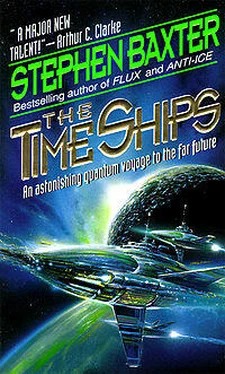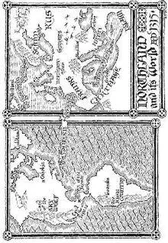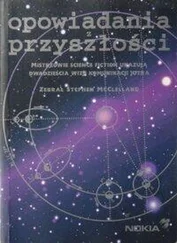The original ball had lost much momentum with these various impacts, and it was fairly creeping by the time it reached the pocket; but it slid into the pocket, and disappeared.
We were left with the copy of the ball which had emerged so mysteriously from the pocket. I picked it up and examined it. As far as I could tell it was an identical copy of our ball. And when I checked the cache beneath the pocket — it was empty! Our original ball had gone, as if it had never existed. “Well!” I said to Nebogipfel. “This table is trickier than I imagined. What do you suppose happened there? Is this the sort of thing which goes on, do you think, during the disturbed paths — all that rattling — which I’ve pointed out to you before?”
Nebogipfel did not reply immediately, but — after that — he took to devoting a substantial fraction of his time, with me, to the puzzles of that strange billiards table. As for me, I tried inspecting the table itself, hoping to find some concealed device, but I found nothing — no trickery, no concealed traps which could swallow and disgorge balls. Besides, even if there had been such crude illusion-machinery, I would still have to find an explanation for the apparent identity of “old” and “new” balls!
The thing which caught my mind — though I had no explanation for it at the time — was the odd, greenish glow of the pocket rims. For all the world, that glow reminded me of Plattnerite.
Nebogipfel told me of what he had learned of the Constructors. Our silent friend in Nebogipfel’s living-room was, it seemed, one of a widespread species: the Constructors inhabited the earth, the transformed planets — and even the stars.
He told me, “You must put aside your preconceptions and look at these creatures with an open mind. They are not like humans.”
“That much I can accept.”
“No,” he insisted, “I do not think you can. To begin with, you must not imagine that these Constructors are individual personalities — after the fashion of you, or me. They are not men in cloaks of metal! They are something qualitatively different.”
“Why? Because they are composed of interchangeable parts?”
“Partly. Two Constructors could flow into one another — merging like two drops of liquid, forming one being — and then part as easily, forming two again. It would be all but impossible — and futile — to trace the origins of this component or that.”
Hearing that, I could understand how it was that I never saw the Constructors moving about the ice-coated landscape outside. There was no need for them to lug the weight of their great, clumsy bodies about (unless for a special need, as when Nebogipfel and I had been repaired ). It would be enough for the Constructor to disassemble himself, into these molecular components Nebogipfel described. The components could wiggle across the ice, like so many worms!
Nebogipfel went on, “But there is more to the Constructors’ consciousness than that. The Constructors live in a world we can barely imagine — they inhabit a Sea, if you like, a Sea of Information.”
Nebogipfel described how, by phonograph and other links, the Universal Constructors were linked to each other, and they used those links to chatter to each other constantly. Information — and awareness, and a deepening understanding — flowed out of the mechanical mind of each Constructor, and each received news and interpretation from every one of his brothers: even those on the most remote stars.
So rapid and all-encompassing was the Constructors’ mode of communication, in fact, that it was not really analogous to human speech, said Nebogipfel.
“But you’ve spoken to them. You’ve managed to get Information out of them. How so?”
“By mimicking their own ways of interacting,” Nebogipfel said. He fingered his eye-socket, gingerly. “I had to make this sacrifice.” His natural eye gleamed.
Nebogipfel had sought a way, as it were, to immerse his brain into the Information Sea of which he’d spoken. Through the eyesocket, he was able to absorb Information directly from the Sea — without its passing through the conventional medium of speech.
I found myself shuddering, at the thought of such an invasion of the comfortable darkness of my own skull! “And do you think it was worth it?” I asked him. “This sacrifice of an eye?”
“Oh, yes. And more… Look — can you see how it is for the Constructors?” he asked me. “They are a different order of life — united, not just by this sharing at the gross physical level, but by this pooling of their experiences. Can you imagine how it is to exist in such a medium of Information as their Sea?”
I reflected. I thought of seminars at the Royal Society — those rich discussions when some new idea has been tossed into the pool, and three dozen agile minds battled over it, reshaping and refining it as they go — or even some of my old Thursday night dinner parties, when, with the help of liberal quantities of wine, the rattle of ideas could come so thick and fast it was hard to tell where one man had stopped speaking and the next resumed.
“Yes,” Nebogipfel cut in when I related this last. “Yes, that is exactly it. Do you see? But with these Universal Constructors, such conversations proceed continuously — and at the speed of light, with thoughts passing directly from the mind of one to another.
“And in such a miasma of communication, who can say where the consciousness of one finishes, and that of another begins? Is this my thought, my memory — or yours? Do you see? Do you follow the implications?”
On the earth — perhaps on each inhabited world — there must be immense central Minds, composed of millions of the Constructors, fused together into great, God-like entities, which maintained the awareness of the race. In a sense, Nebogipfel said, the race itself was conscious.
Again I had the feeling that we were straying too far into metaphysics. “All of that is fascinating stuff,” I said, “and it’s all as may be; but perhaps we should return to the practicalities of our own situation. What does it all have to do with you and me?” I turned to our own patient Constructor, who sat there, shimmering, in the middle of the floor. “What of this fellow?” I said. “All of this stuff about consciousness and so forth is all very well — but what does he want? Why is he here? Why did he save our lives? And — what does he want with us now? Or is it a case of these mechanical men all working together — like bees in a hive, united by these common Minds you speak of — so that we are faced with a species with common aims?”
Nebogipfel rubbed his face. He walked up to the Constructor, peered into his eye-scope, and was rewarded, within a few minutes, by the extrusion, from within the Constructor’s glistening body, of a plate of that bland, cheese-like food of which I had seen so much in Nebogipfel’s home century. I watched with disgust, as Nebogipfel took the plate and bit into his regurgitated food. It was no more horrible, truthfully, than the extrusion of materials from the Floor of the Morlocks’ Sphere, but there was something about the Constructor’s liquid mixture of Life and Machine which repelled me. I averted my thoughts, with determination, from speculations as to the source of my own food and water!
“We cannot talk of these Constructors as united,” Nebogipfel was saying. “They are linked. But they do not share a common purpose — in the fashion, let us say, of the various components of your own personality.”
“But why not? That would seem eminently sensible. With perfect, continuous communication there need be no understanding — no conflict.”
Читать дальше
Конец ознакомительного отрывка
Купить книгу









